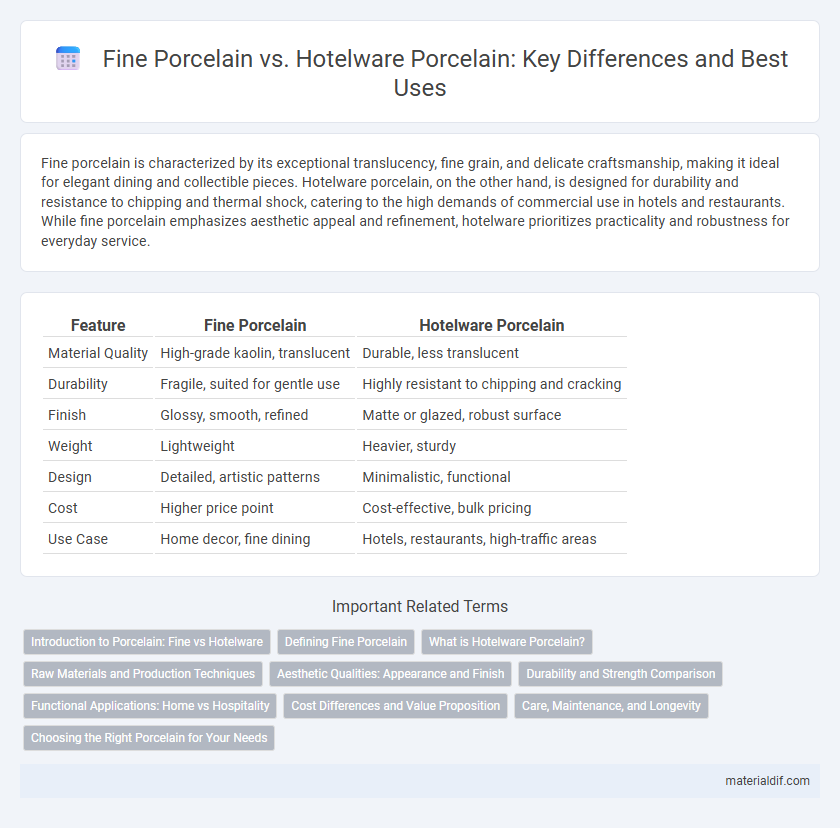Fine porcelain is characterized by its exceptional translucency, fine grain, and delicate craftsmanship, making it ideal for elegant dining and collectible pieces. Hotelware porcelain, on the other hand, is designed for durability and resistance to chipping and thermal shock, catering to the high demands of commercial use in hotels and restaurants. While fine porcelain emphasizes aesthetic appeal and refinement, hotelware prioritizes practicality and robustness for everyday service.
Table of Comparison
| Feature | Fine Porcelain | Hotelware Porcelain |
|---|---|---|
| Material Quality | High-grade kaolin, translucent | Durable, less translucent |
| Durability | Fragile, suited for gentle use | Highly resistant to chipping and cracking |
| Finish | Glossy, smooth, refined | Matte or glazed, robust surface |
| Weight | Lightweight | Heavier, sturdy |
| Design | Detailed, artistic patterns | Minimalistic, functional |
| Cost | Higher price point | Cost-effective, bulk pricing |
| Use Case | Home decor, fine dining | Hotels, restaurants, high-traffic areas |
Introduction to Porcelain: Fine vs Hotelware
Fine porcelain features a refined, translucent composition made from high-quality kaolin clay, offering superior elegance and durability for upscale table settings. Hotelware porcelain, designed for heavy use in commercial environments, combines strength and chip resistance with a more practical, thicker structure to withstand frequent handling and washing. Both types utilize advanced firing techniques but differ significantly in finish, weight, and intended application, making selection crucial based on durability versus aesthetic priorities.
Defining Fine Porcelain
Fine porcelain is characterized by its high-quality materials, including refined kaolin clay, which results in exceptional translucency, strength, and a smooth, white surface. It is fired at higher temperatures, enhancing durability and producing a delicate, elegant finish ideal for luxury tableware and decorative pieces. Unlike hotelware porcelain, which prioritizes sturdiness and cost-efficiency for commercial use, fine porcelain emphasizes aesthetic appeal and craftsmanship.
What is Hotelware Porcelain?
Hotelware porcelain is specifically designed for commercial use in hotels and restaurants, emphasizing durability and resistance to chipping, thermal shock, and heavy daily use. Unlike fine porcelain, which prioritizes delicate craftsmanship and aesthetic appeal, hotelware porcelain features thicker walls and reinforced edges to withstand frequent handling and intensive washing cycles. Its formulation typically includes additives that enhance strength and longevity, ensuring reliable performance in high-traffic hospitality environments.
Raw Materials and Production Techniques
Fine porcelain is crafted using high-quality kaolin clay, feldspar, and quartz, resulting in a dense, translucent, and delicate material. Hotelware porcelain incorporates more durable raw materials and often includes additives such as bone ash or synthetic compounds to enhance strength and chip resistance for heavy use. Production techniques for fine porcelain involve slower, high-temperature firing cycles to achieve a smooth, elegant finish, whereas hotelware porcelain undergoes rapid, high-temperature firing processes to prioritize durability and mass production efficiency.
Aesthetic Qualities: Appearance and Finish
Fine porcelain features a translucent, smooth surface with a delicate, pristine white appearance that enhances intricate design details and elegant glazing techniques. Hotelware porcelain prioritizes durability while maintaining a polished finish, often exhibiting a slightly thicker body and less translucency to withstand heavy usage. The aesthetic appeal of fine porcelain aligns with luxury and refined presentation, whereas hotelware porcelain balances functionality with a clean, professional look suitable for high-traffic hospitality settings.
Durability and Strength Comparison
Fine porcelain is known for its delicate translucency and refined aesthetic, but it tends to be more brittle and less resistant to chips and cracks compared to hotelware porcelain. Hotelware porcelain, engineered for commercial use, prioritizes durability and strength, featuring thicker walls and enhanced resistance to thermal shock and heavy handling. This makes hotelware porcelain ideal for high-traffic environments where longevity and toughness are critical.
Functional Applications: Home vs Hospitality
Fine porcelain features delicate craftsmanship and translucent quality, making it ideal for elegant home dining and decorative purposes. Hotelware porcelain is engineered for durability and resistance to chipping, suited for the rigorous, high-frequency use in hospitality settings such as restaurants and hotels. Functional applications highlight fine porcelain's aesthetic value in private homes, while hotelware porcelain emphasizes practicality and longevity in commercial environments.
Cost Differences and Value Proposition
Fine porcelain commands higher prices due to its superior translucency, refined clay, and meticulous craftsmanship, making it ideal for luxury dining with enhanced durability and aesthetic appeal. Hotelware porcelain offers cost-effective solutions with thicker construction and greater chip resistance, designed to withstand frequent commercial use and minimize replacement expenses. The value proposition centers on balancing initial investment against longevity and presentation, where fine porcelain suits upscale settings and hotelware meets practical demands in high-traffic environments.
Care, Maintenance, and Longevity
Fine porcelain requires gentle handling and hand washing with mild detergents to preserve its delicate glaze and intricate patterns, ensuring long-lasting beauty. Hotelware porcelain, designed for durability, withstands frequent use and aggressive cleaning methods, including commercial dishwashers, without significant damage. Proper care tailored to the porcelain type significantly extends its lifespan, maintaining both function and aesthetic appeal.
Choosing the Right Porcelain for Your Needs
Fine porcelain, known for its delicate translucency and high-quality clay composition, offers exceptional aesthetic appeal and is ideal for formal dining or decorative purposes. Hotelware porcelain, designed for durability and resistance to chipping and thermal shock, suits high-traffic commercial environments such as restaurants and hotels. Selecting the right porcelain involves balancing elegance with practicality, considering factors like usage frequency, cost efficiency, and maintenance requirements.
Fine Porcelain vs Hotelware Porcelain Infographic

 materialdif.com
materialdif.com